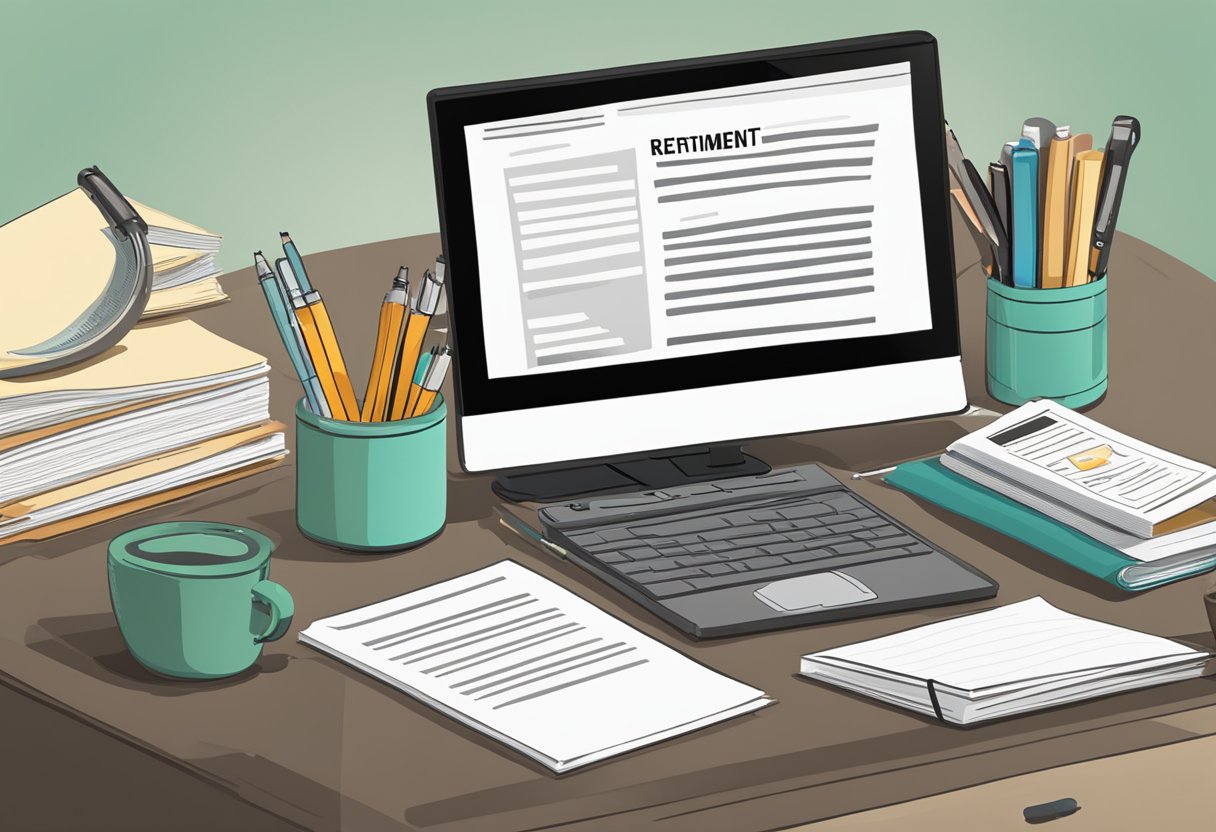How to Write a Retirement Letter: Your Complete Sample and Guide
Writing a retirement letter is a significant step in transitioning from a professional career to the next phase of life. It serves as a formal notification to your employer of your departure, while also giving you the opportunity to express gratitude for the years spent at the company. Crafting a clear and respectful retirement letter is important as it sets the tone for your departure and can leave a lasting impression on your colleagues and superiors.

It's essential to understand the purpose of a retirement letter and approach writing it with the right structure and content. A well-written letter will include the basics of your announcement, any necessary details regarding your transition out of the company, and personal touches that reflect your relationship with the employer. Finalizing the letter with a professional tone and ensuring it’s delivered in an appropriate manner are key to maintaining professionalism.
Key Takeaways
- A retirement letter formally announces an employee’s departure and shows appreciation for their time at the company.
- Careful structuring and content choice in the letter can facilitate a smooth transition and maintain positive relationships.
- Professional final touches and delivery methods reflect a respectful and considerate approach to retirement.
Understanding the Purpose of a Retirement Letter

A retirement letter serves as a formal notification to an employer, signifying an employee's intention to leave their position due to retirement. This letter is an important document because it initiates the transition process from active work to retirement. The main purposes of a retirement letter include:
- Clear Communication: It informs the employer about the exact date of retirement, ensuring there are no misunderstandings regarding the timeline.
- Professional Courtesy: Writing a retirement letter is a matter of professional etiquette. It shows respect for the employer and the company by announcing the retirement formally.
- Transition Planning: It allows the employer ample time to plan for a replacement or to reallocate duties among existing staff, thus minimizing disruptions in the workflow.
- Record Keeping: The letter becomes a part of the employee’s personnel file, serving as an official record of retirement for both parties.
Here are key components one should include in a retirement letter, as per expert guidelines in this area:
- Date of Retirement: Clearly state when the retirement is effective.
- Expression of Gratitude: Offer thanks for the opportunities provided during the tenure.
- Offer to Assist: Indicate willingness to help with the transition, if possible.
For guidance on drafting a retirement letter consistent with good practices, individuals might refer to resources such as Resume Genius for sample letters and additional advice.
Preparing to Write Your Retirement Letter

Before one begins drafting a retirement letter, it's important for the writer to gather thoughts on career highlights, determine the best timing for their departure, and decide who will be receiving the letter.
Reflect on Your Career Accomplishments
One should take the time to consider the significant achievements and contributions they’ve made during their tenure. This may include successful projects, leadership roles, or any positive changes they've influenced within the company. These reflections not only provide content for the letter but also help articulate the legacy they are leaving behind.
Consider the Timing of Your Departure
Choosing the right time to retire is crucial. The writer should ensure that they are adhering to any contractual notice periods and consider how the timing will affect the transition for both themselves and the company. It’s respectful to allow the employer ample time to find a suitable replacement.
Identify the Letter's Recipients
The primary recipient of a retirement letter is typically one's immediate supervisor. Additionally, it may be necessary to provide copies to the Human Resources department and any relevant management. Identifying all the recipients beforehand ensures that everyone who needs to be informed about the retirement is included.
Structuring Your Retirement Letter

A well-structured retirement letter serves as a formal announcement and a token of appreciation towards the employer. It also lays the foundation for a smooth transition.
Opening with a Professional Greeting
The letter should start with a professional salutation. It is customary to address the immediate supervisor or the department head directly. For example: "Dear [Supervisor's Name],"
Announcing Your Retirement
The first paragraph should clearly state the intent to retire. Mention the effective date of retirement to provide clarity. For example: "I am writing to inform you of my decision to retire, effective [date]."
Expressing Gratitude
A section dedicated to gratitude recognizes the opportunities and experiences gained during employment. It is appropriate to mention specific instances or projects that were particularly meaningful.
Discussing Transition Plans
Concluding the letter should include a brief discussion of the plans to ensure a smooth transition. Offering assistance with training a successor or providing insights on pending projects is valuable.
Writing the Content of Your Retirement Letter
Crafting the content of a retirement letter requires careful consideration. The letter should reflect a professional tone while also expressing genuine sentiments about the departure.
Personalization and Tone
A retiring individual should write in a tone that is both professional and cordial. It’s beneficial to express gratitude for the opportunities provided by the company and to share any notable experiences or accomplishments during tenure. Acknowledging colleagues and the organization positively will leave a lasting good impression. The tone should remain formal yet warm, reaffirming the employee's commitment to a smooth transition.
- Example: "I am deeply grateful for the support and opportunities I've received during my time with XYZ Corp. Working alongside such a dedicated team has been one of the highlights of my career."
Providing Contact Information Post-Retirement
It is customary to include post-retirement contact information. This allows for continued connection and aids with any necessary follow-up communication. Be clear about the preferred method and how to reach you.
- Email: jane.doe@email.com
- Phone: (555) 123-4567
Indicate the circumstances in which reaching out would be appropriate if you wish to specify. This helps set boundaries while maintaining professional connections.
Closing Your Retirement Letter
The conclusion of one's retirement letter is as crucial as its commencement. It presents an opportunity for a final farewell and a reiteration of gratitude towards colleagues and the organization.
Words of Farewell
A retirement letter should conclude on a warm and personal note. It is appropriate to express sentiments of farewell, such as:
- Best wishes to all as I move onto the next chapter in my life.
- I will cherish the memories and experiences gained here.
Reiteration of Appreciation
Before signing off, one should underscore their appreciation for the opportunities provided by the company:
- Thank you once again for the support and encouragement.
- I am grateful for the years of professional growth and collaboration.
Finalizing Your Letter
Before sending out your retirement letter, it's crucial to ensure it's polished and error-free. This final step reinforces your professionalism and leaves a lasting positive impression.
Proofreading for Errors
Carefully proofread your retirement letter to correct any spelling, grammar, or punctuation mistakes. A retirement letter free of errors reflects the writer's attention to detail and respect for the recipient. They may want to read it aloud or use digital tools to help identify any overlooked issues.
Professional Formatting
One should follow a consistent, professional format throughout their letter. Use a standard font like Times New Roman or Arial, and ensure the font size is legible, typically 12 points. The letter should be single-spaced, with a space between paragraphs, and margins should be 1" on all sides. Align your text to the left for easy reading.
Sample Retirement Letters
Crafting a retirement letter can be an important step in transitioning to the next stage of life. For a long-term employee, the tone can often reflect reflection on a substantial career, while a letter from a short-term employee might focus more on the immediate transition.
Letter for a Long-Term Employee
To: [Supervisor's Name]
Cc: Human Resources
Dear [Supervisor's Name],
I write to you today to announce my retirement from [Company Name], effective [Last Working Day]. Having dedicated [Number of Years] years to the growth and success of the company, this decision comes with a mix of emotions. My journey here has been filled with invaluable lessons, and meaningful connections that I will cherish into retirement.
During my tenure, I have witnessed and contributed to numerous milestones that have shaped the current success of [Company Name]. I am proud to have been a part of a community that not only values hard work but also fosters personal growth.
As I transition into retirement, I am committed to ensuring a smooth handover of my responsibilities. Over the next [Time Period], I will collaborate with my team to ascertain that all my duties are fully transferred to my successor.
Thank you for the support and opportunities provided to me over the years. I look forward to observing the company's future successes.
Warm regards,
[Your Name]
Letter for a Short-Term Position
To: [Supervisor's Name]
Cc: Human Resources
Dear [Supervisor's Name],
Please accept this letter as formal notification of my decision to retire from my role as [Your Position] at [Company Name], effective [Last Working Day]. Although my time with the company has been brief, amounting to [Number of Years or Months], it has been an immensely rewarding and educational period.
In preparation for my departure, I have compiled a comprehensive handover document to ensure no disruption to the workflow. I am also willing to assist with training my replacement and will do my utmost to make the transition seamless.
I am grateful for the opportunity to have worked with such a talented team and for the professional development I have gained during my time here. I carry forward positive experiences and skills honed here into the next chapter of my life.
Sincerely,
[Your Name]
Tips for Delivering Your Retirement Letter
In preparing to share a retirement letter, focusing on timing and the method of delivery is crucial, as is ensuring follow-up after the letter has been submitted. These steps can help provide a smooth transition into retirement.
Choosing the Right Time and Medium
Time: Optimal timing involves submitting the retirement letter at a time that respects both the individual's plans and the needs of the employer. A standard practice is to provide this letter well in advance, typically at least two to three months before the planned retirement date. This time frame gives an employer sufficient opportunity to begin the process of finding a replacement.
Medium: In terms of delivery medium, professionalism dictates a hard copy as the primary method, addressed to the immediate supervisor with a copy for the human resources department. However, if company culture and modern practices allow, an electronic copy via email may be suitable, provided that it is sent in a professional format.
Follow-up After Submission
After delivering the retirement letter, it is recommended to verify its receipt. This can be done through a simple email or in-person inquiry. Ensure to ask if further information or actions are required on part of the retiring employee. Maintaining open lines of communication with both the supervisor and HR can help address any final details or procedures leading up to the retirement date.
Frequently Asked Questions
Writing a retirement letter is a significant step in one's career. These FAQs are aimed at giving you a comprehensive understanding of the components and etiquette involved.
What are the essential components to include in a retirement letter?
A retirement letter should include your intention to retire, the effective date of your retirement, and a thank you to your employer for the opportunities provided. It's also courteous to offer help during the transition period.
How can I effectively communicate my retirement to my employer?
To communicate your retirement effectively, schedule a meeting with your employer to discuss your intentions before submitting a formal letter. This ensures a personal touch and demonstrates respect.
What is the proper etiquette for submitting a retirement letter?
Proper etiquette involves addressing your letter to your immediate supervisor and providing a copy to the human resources department. This process facilitates a smooth transition regarding benefits and retirement plans.
How far in advance should I submit my retirement letter to my employer?
Usually, it is advisable to submit a retirement letter at least 30 days in advance. However, some positions may require a longer notice period to find a suitable replacement or transition the job responsibilities effectively.
Can you provide a structure for a graceful retirement letter?
A graceful retirement letter typically begins with a statement of intent to retire, followed by a specified retirement date. It's important to express gratitude, reflect on positive experiences, and conclude with an offer to assist with the transition.
What are some tips for personalizing a retirement letter while keeping it professional ?
To personalize your retirement letter while maintaining professionalism, mention specific experiences or projects that were meaningful to you. Also, acknowledge the relationships and growth you've encountered during your tenure without forgoing a formal tone.

Get a higher quality resume format
Our Resume Builder ensures best practices, logic, formatting standards and job matching opportunities from thousands of job boards and portals around the world.
By clicking Start Your Resume, Your are agree to our Terms of use and Privacy Policy
 India's
premier resume service
India's
premier resume service






